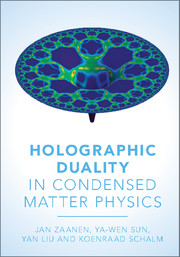Book contents
- Frontmatter
- Contents
- Preface
- 1 Introduction
- 2 Condensed matter: the charted territory
- 3 Condensed matter: the challenges
- 4 Large-N field theories for holography and condensed matter
- 5 The AdS/CFT correspondence as computational device: the dictionary
- 6 Finite-temperature magic: black holes and holographic thermodynamics
- 7 Holographic hydrodynamics
- 8 Finite density: the Reissner–Nordström black hole and strange metals
- 9 Holographic photoemission and the RN metal: the fermions as probes
- 10 Holographic superconductivity
- 11 Holographic Fermi liquids: the stable Fermi liquid and the electron star as holographic dual
- 12 Breaking translational invariance
- 13 AdS/CMT from the top down
- 14 Outlook: holography and quantum matter
- References
- Index
11 - Holographic Fermi liquids: the stable Fermi liquid and the electron star as holographic dual
Published online by Cambridge University Press: 05 November 2015
- Frontmatter
- Contents
- Preface
- 1 Introduction
- 2 Condensed matter: the charted territory
- 3 Condensed matter: the challenges
- 4 Large-N field theories for holography and condensed matter
- 5 The AdS/CFT correspondence as computational device: the dictionary
- 6 Finite-temperature magic: black holes and holographic thermodynamics
- 7 Holographic hydrodynamics
- 8 Finite density: the Reissner–Nordström black hole and strange metals
- 9 Holographic photoemission and the RN metal: the fermions as probes
- 10 Holographic superconductivity
- 11 Holographic Fermi liquids: the stable Fermi liquid and the electron star as holographic dual
- 12 Breaking translational invariance
- 13 AdS/CMT from the top down
- 14 Outlook: holography and quantum matter
- References
- Index
Summary
In chapter 9 we introduced the holographic description of single-fermion propagators in the finite-density Reissner–Nordström metals. We discussed in particular how sharp Fermi surfaces can arise due to the approximate confinement of fermionic excitations in the potential well created by the geometrical domain wall. The interaction of these fermionic quasi-bound states with the strongly coupled AdS2 IR gives these a finite lifetime. Eventually it decays into the quantum critical horizon, and this imbues the state with its non-Fermi-liquid properties. For particular parameter choices these fermionic responses can closely resemble the “marginal-Fermi-liquid” spectral functions suggested by photoemission experiments in the cuprate strange metals. However, these computations involved an approximation in the form of the probe limit, which assumed that the bulk fermions do not influence the bulk physics.
But the reader is now familiar with holographic superconductivity, a context where the limitations of the probe limit become very explicit: the violation of the BF bound by the fluctuations of a scalar field in the bulk signals an instability of the vacuum, and one has to recompute the response after the backreaction of the scalar field has been fully accounted for. Ignoring this amounts to computing the physics of an unstable, false vacuum. We emphasised in chapter 9 that a similar issue arises in the parameter regime of the fermion scaling dimension and charge where the holographic Fermi surface is formed. Invariably the fermion propagators show in this regime a log-oscillatory behaviour at small momenta, which is caused by a BF-bound violation of the bulk fermions. The physics in the bulk behind this log-oscillatory behaviour is Schwinger pair production in the background of the charged black hole. Although the physics is less straightforward than for the bosonic fields, it does indicate that the system is unstable – the Fermi surfaces of chapter 9 are properties of a false vacuum. To stabilise the bulk it has to be that the fermionic states in the bulk get occupied. In the true ground state the bulk fermions have to have a macroscopic effect themselves, and the only way this can be accomplished is by forming finite-density fermionic matter. The bulk fermions are non-interacting to leading order in 1/N, but they are still subject to Fermi–Dirac statistics. Thus a finite-density Fermi gas has to form in the bulk with a charge and energy density that will modify the gauge fields and the geometry.
- Type
- Chapter
- Information
- Holographic Duality in Condensed Matter Physics , pp. 377 - 416Publisher: Cambridge University PressPrint publication year: 2015



